Strength training has exploded in popularity over the last decade, and for good reason. Not only does it help you lose weight and build lean muscle, but it also supports better bone health, boosts metabolism, and even improves mental well-being. Yet, for beginners, stepping into the world of barbells, dumbbells, and resistance bands can feel overwhelming. This guide breaks down the fundamentals of strength training in a way that’s approachable, practical, and designed to set you up for long-term success.
What Is Strength Training?
At its core, strength training is any exercise that makes your muscles work against resistance. That resistance might come from free weights, cardio equipment with resistance features (like rowing machines or ski ergs), resistance bands, or even your own body weight. The goal is simple: improve muscular strength, endurance, and power.
Benefits at a Glance
- Fat Loss & Muscle Gain: Strength training helps burn calories long after your workout is done.
- Bone Density: Lifting weights reduces the risk of osteoporosis.
- Posture & Mobility: Pairing strength with flexibility & mobility work improves alignment.
- Mental Health: Training boosts confidence and reduces stress.
How to Start Safely
Many beginners think they need to lift as heavy as possible on day one. Not true. Focus on form first, load later.
Step 1: Learn the Fundamental Movements
- Squat: Builds strength in legs and core, improves balance & stability.
- Deadlift: Strengthens the posterior chain (glutes, hamstrings, back).
- Press: Overhead and bench presses target shoulders, chest, and triceps.
- Row: Balances pressing by strengthening your back and biceps.
Step 2: Frequency & Recovery
Aim for 2–3 strength sessions per week to start. Allow at least one rest day between heavy sessions. Use recovery tools like foam rollers or massage guns to ease soreness.
Step 3: Progress Gradually
Increase weight by 5–10% when movements feel smooth and controlled. Don’t rush — consistency beats intensity.
Common Mistakes Beginners Make
Mistake 1: Skipping Warm-Ups
Dynamic stretching and mobility drills prep your body, improve range of motion, and reduce injury risk.
Mistake 2: Ignoring Recovery
Without adequate sleep, nutrition, and stretching, your progress stalls. Incorporating yoga or mindful movement sessions once a week helps with relaxation and mobility.
Mistake 3: Over-Complicating Workouts
Stick to simple, proven moves before diving into fancy circuits. Functional fitness doesn’t need to be flashy.
Integrating Strength Training with Other Fitness Goals
Cardio & Strength
Using cardio equipment like rowing machines or air bikes after lifting can enhance endurance while keeping heart health in check.
Flexibility & Mobility
Post-lift stretching and Pilates-inspired core training build a resilient, injury-proof body.
Functional Fitness & Outdoor Work
Blend strength with outdoor fitness like hill sprints, kettlebell carries, or calisthenics in the park. These mimic real-life movement patterns.
Studio vs. Home Gym
Whether you’re working out at a professional studio with high-end rigs or building your own setup with home gym essentials, consistency is key. Even portable fitness tools like resistance bands are enough to start.
Actionable Tips for Beginners
- Start with Bodyweight: Master squats, push-ups, planks before adding heavy weights.
- Invest in Basics: Dumbbells, a pull-up bar, and resistance bands are excellent strength accessories.
- Track Progress: Keep a log — weights, reps, sets.
- Mind Recovery: Dedicate time to stretching, foam rolling, and active recovery.
- Explore New Arrivals: Stay inspired by trying the latest gear trends that fit your budget and training style.
Strength training is more than just lifting weights; it’s about building a healthier, more capable version of yourself. By starting small, learning proper form, and balancing your routine with cardio, mobility, and recovery, you set yourself up for long-term success.
Ready to take the next step? Subscribe to our newsletter for beginner-friendly workouts, gear reviews, and wellness tips. And don’t forget to check out related reads like Home Gym Essentials and Top Recovery Tools. Your journey toward strength and well-being starts today.

